Windows of opportunity
Two artists created a new iconography for Grace Hopper College.
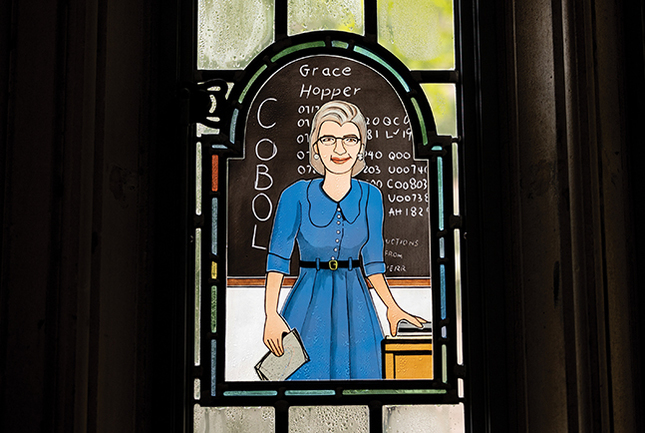 Allie BartonNew York artist Faith Ringgold is known for paintings, quilts, performance art, and children’s books, created over a career spanning seven decades, but she had never worked in glass before. Yale commissioned her to create six windows for the Grace Hopper common room, replacing six that had depicted the life and career of John C. Calhoun. Employing her colorful, folk art–inspired illustration style, Ringgold crafted one of the windows so as to depict Grace Hopper herself (above), standing at a blackboard with lines of computer code and the word “COBOL,” the computer language she helped develop.
View full image Allie BartonNew York artist Faith Ringgold is known for paintings, quilts, performance art, and children’s books, created over a career spanning seven decades, but she had never worked in glass before. Yale commissioned her to create six windows for the Grace Hopper common room, replacing six that had depicted the life and career of John C. Calhoun. Employing her colorful, folk art–inspired illustration style, Ringgold crafted one of the windows so as to depict Grace Hopper herself (above), standing at a blackboard with lines of computer code and the word “COBOL,” the computer language she helped develop.
View full image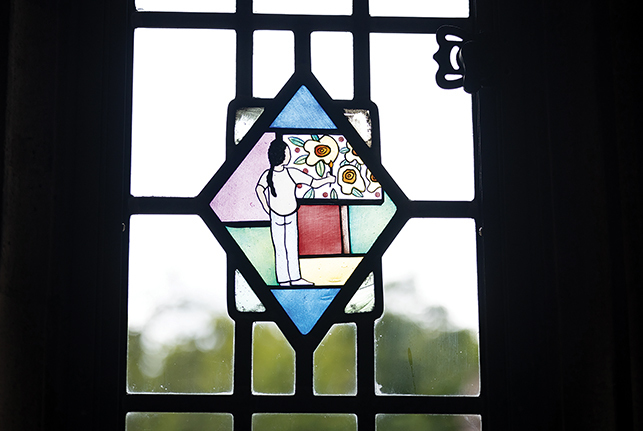 Allie BartonIn the other five windows, Ringgold depicts students at work and play, a choice that head of college Julia Adams says is fitting for the common room, which she calls a “vibrant focal point of student life.” Two of the windows feature student artists: a painter (above) . . .
View full image Allie BartonIn the other five windows, Ringgold depicts students at work and play, a choice that head of college Julia Adams says is fitting for the common room, which she calls a “vibrant focal point of student life.” Two of the windows feature student artists: a painter (above) . . .
View full image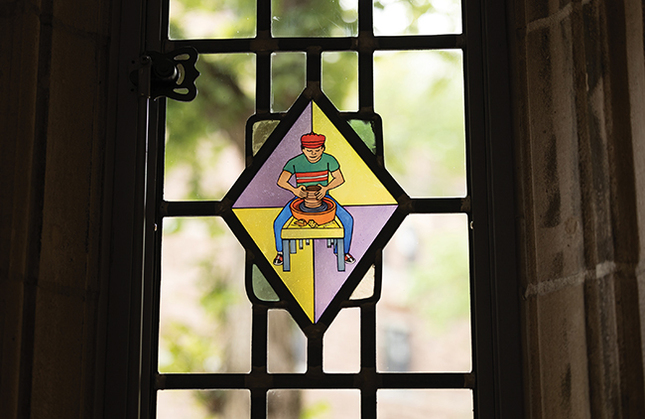 Allie Barton Allie Barton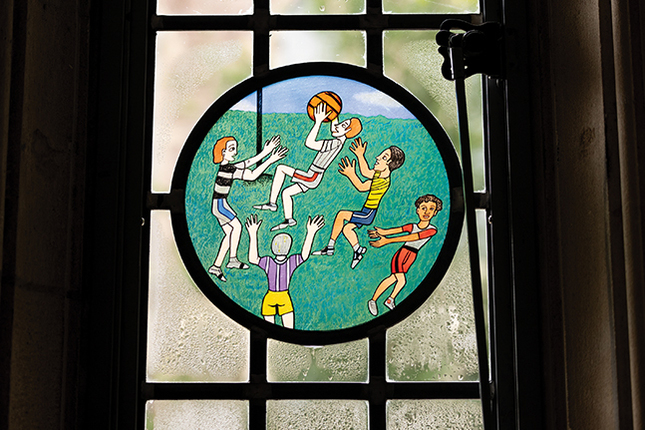 Allie BartonOne window captures a game of pickup basketball.
Ringgold has not shied away from confronting racism and difficult themes over her career, but unlike Barbara Earl Thomas’s designs for the dining hall, Ringgold’s windows don’t address the college’s controversial past. For committee chair Anoka Faruqee ’94, that’s just fine. “It is an expression of joy,” she says. “Black artists should be able to express the joyful aspects of life.”
View full image Allie BartonOne window captures a game of pickup basketball.
Ringgold has not shied away from confronting racism and difficult themes over her career, but unlike Barbara Earl Thomas’s designs for the dining hall, Ringgold’s windows don’t address the college’s controversial past. For committee chair Anoka Faruqee ’94, that’s just fine. “It is an expression of joy,” she says. “Black artists should be able to express the joyful aspects of life.”
View full image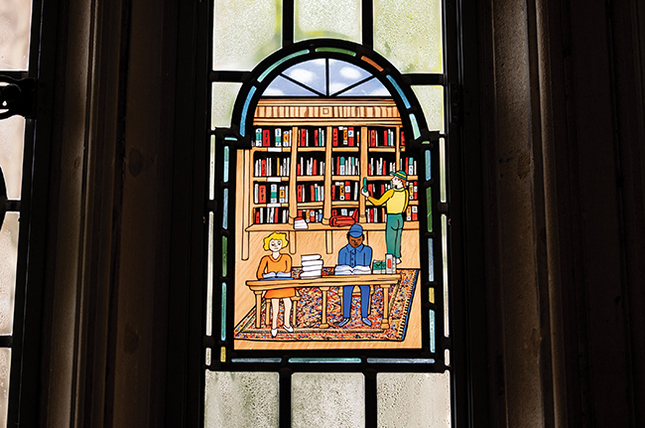 Allie BartonThere are two scenes set in spaces central to every residential college: the library . . .
View full image Allie BartonThere are two scenes set in spaces central to every residential college: the library . . .
View full image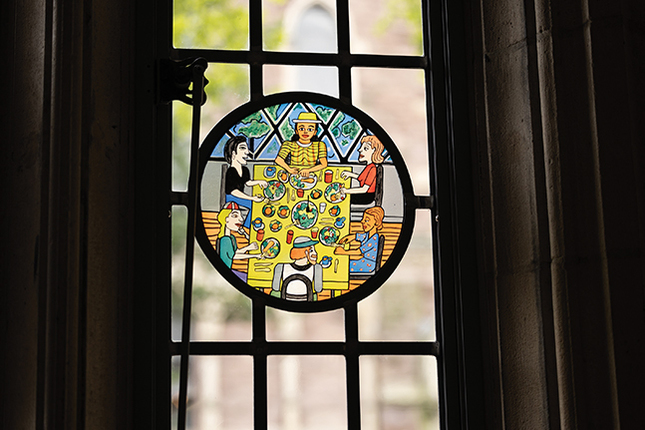 Allie Barton Allie Barton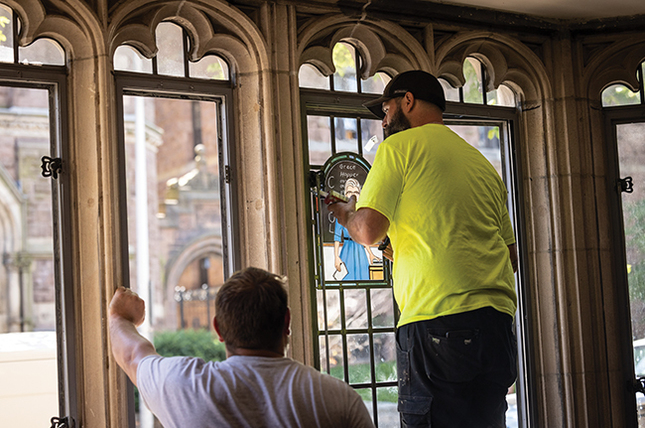 Dan RenzettiRinggold has not shied away from confronting racism and difficult themes over her career, but unlike Barbara Earl Thomas’s designs for the dining hall, Ringgold’s windows don’t address the college’s controversial past. For committee chair Anoka Faruqee ’94, that’s just fine. “It is an expression of joy,” she says. “Black artists should be able to express the joyful aspects of life.”
View full image Dan RenzettiRinggold has not shied away from confronting racism and difficult themes over her career, but unlike Barbara Earl Thomas’s designs for the dining hall, Ringgold’s windows don’t address the college’s controversial past. For committee chair Anoka Faruqee ’94, that’s just fine. “It is an expression of joy,” she says. “Black artists should be able to express the joyful aspects of life.”
View full image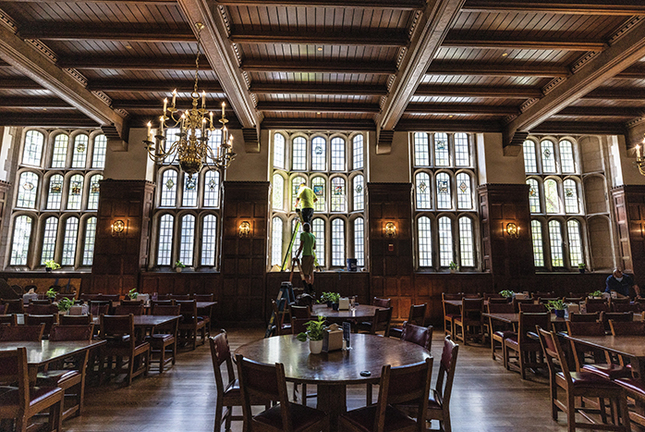 Dan RenzettiIn addition to painting, sculpture, and other media, Seattle artist Barbara Earl Thomas has worked in glass since 2012. When asked to design windows to replace six panels that were removed from the Hopper dining hall, she took on the entire story, with overt references to the college’s name change and the controversy surrounding it.
View full image Dan RenzettiIn addition to painting, sculpture, and other media, Seattle artist Barbara Earl Thomas has worked in glass since 2012. When asked to design windows to replace six panels that were removed from the Hopper dining hall, she took on the entire story, with overt references to the college’s name change and the controversy surrounding it.
View full image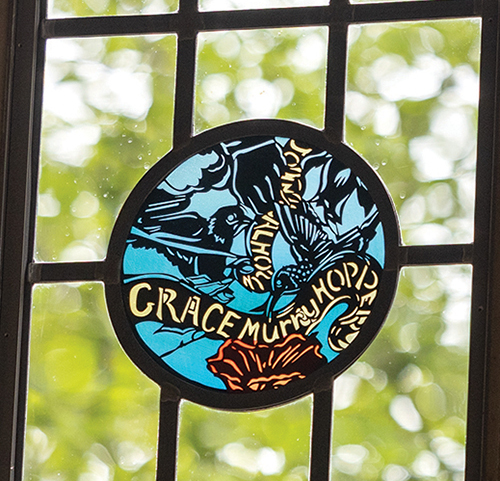 Allie BartonIn a window named “Winds of History,” a robin flies into the background carrying a banner that reads “John C. Calhoun,” while a hummingbird comes to the fore with one that reads “Grace Murray Hopper.”
View full image Allie BartonIn a window named “Winds of History,” a robin flies into the background carrying a banner that reads “John C. Calhoun,” while a hummingbird comes to the fore with one that reads “Grace Murray Hopper.”
View full image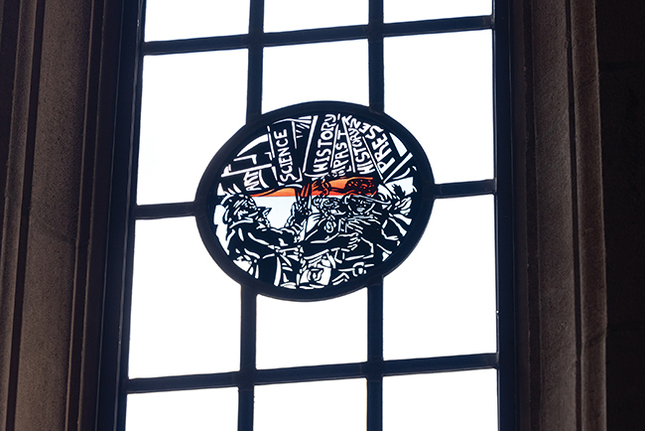 Allie BartonIn an echo of the common room window that showed Calhoun and a kneeling Black man, a window called “Education Is Freedom” shows Calhoun looking at a book labeled “History Past” as a Black man breaking his chains points to the words “History Present.”
View full image Allie BartonIn an echo of the common room window that showed Calhoun and a kneeling Black man, a window called “Education Is Freedom” shows Calhoun looking at a book labeled “History Past” as a Black man breaking his chains points to the words “History Present.”
View full image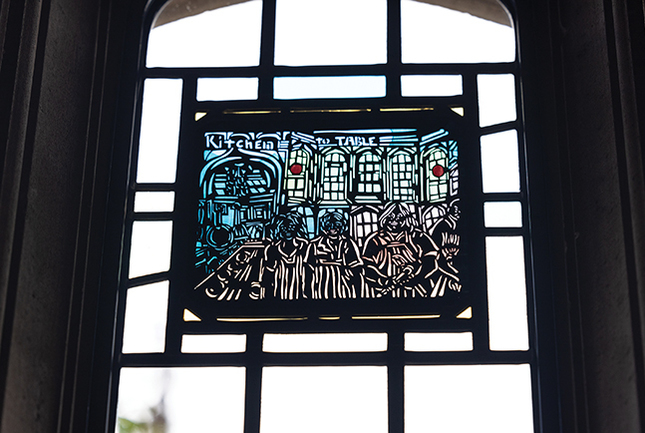 Allie BartonThomas visited campus before the pandemic and later talked to students and dining hall staff on Zoom. In a talk at the Art Gallery in September, she said the rest of the windows came out of those conversations. “There was a unanimous feeling that they wanted something that honored the staff, and the people who agitated” to change the college’s name, she said. So a window called “Kitchen to Table” features four dining hall workers.
View full image Allie BartonThomas visited campus before the pandemic and later talked to students and dining hall staff on Zoom. In a talk at the Art Gallery in September, she said the rest of the windows came out of those conversations. “There was a unanimous feeling that they wanted something that honored the staff, and the people who agitated” to change the college’s name, she said. So a window called “Kitchen to Table” features four dining hall workers.
View full image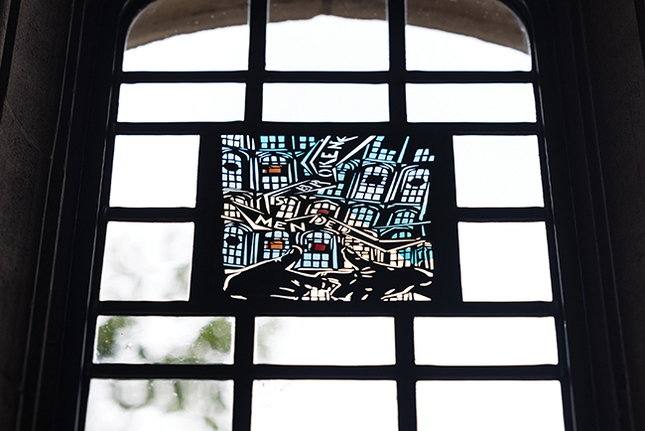 Allie BartonAnother, titled “Broken Is Mended,” refers to the window-breaking incident from 2016. (Thomas had seen the broken window reassembled for an Art Gallery exhibit on American glass in 2019.)
View full image Allie BartonAnother, titled “Broken Is Mended,” refers to the window-breaking incident from 2016. (Thomas had seen the broken window reassembled for an Art Gallery exhibit on American glass in 2019.)
View full image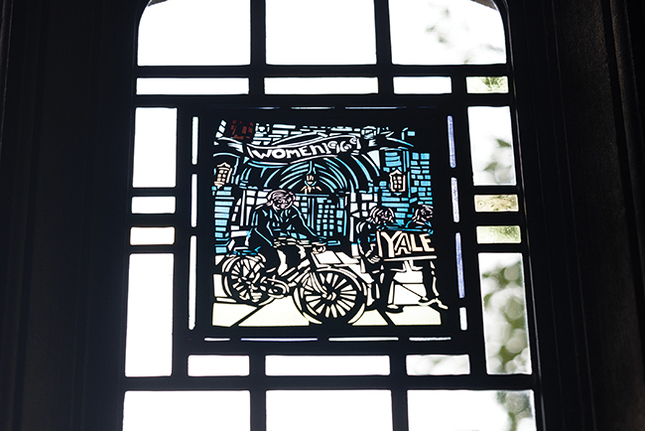 Allie BartonThe other two windows address other topics in Yale life and history. “Women at Yale” celebrates the advent of coeducation in Yale College in 1969.
View full image Allie BartonThe other two windows address other topics in Yale life and history. “Women at Yale” celebrates the advent of coeducation in Yale College in 1969.
View full image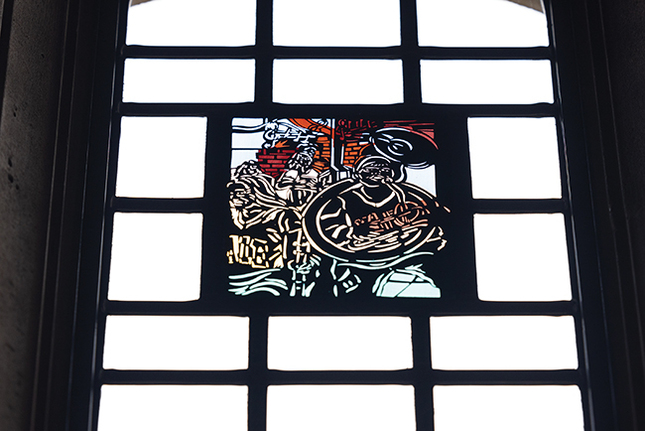 Allie Barton“Student Life/Joyful Noise” depicts students singing and playing instruments. “When I visited Yale, I heard the choir and music in the quad drift in during late night hours,” she explained. “It seemed emblematic, and a core part of student life at Yale.”
View full image Allie Barton“Student Life/Joyful Noise” depicts students singing and playing instruments. “When I visited Yale, I heard the choir and music in the quad drift in during late night hours,” she explained. “It seemed emblematic, and a core part of student life at Yale.”
View full imageThe debate over the name of Calhoun College had been going on for years by June 13, 2016, when Corey Menafee, a Black dishwasher in the college, took a broomstick and shattered a stained-glass window in the dining hall that depicted enslaved people picking cotton. “It’s 2016,” he told the New Haven Independent. “I shouldn’t have to come to work and see things like that.”
Menafee acted just weeks after Yale announced that it would not change the name of the college, which had been named in 1931 for John C. Calhoun (1782–1850), a Yale alumnus, US senator, vice president, and tireless champion of slavery. (Menafee expressed regret and resigned after the incident, but was soon rehired by the university in a different job.)
It wasn’t the first time windows had been a battleground at Calhoun. In the 1990s, students objected to a window in the college’s common room that showed an enslaved person in chains kneeling at Calhoun’s feet. The college master had the image of the Black man removed from the panel—but kept Calhoun.
So when Yale reversed its decision in 2017 and renamed Calhoun for pioneering computer scientist Grace Hopper ’34PhD, a thorny question arose: what do we do with those windows? The altered panel in the common room was one of six in a bay window depicting Calhoun’s life; they were all removed. The dining hall featured three dozen panels with “romanticized images of antebellum southern life,” as Julia Adams, head of the college, puts it. Most are innocuous images of Southern flora, fauna, and architecture, but Adams and a college committee decided that six of them—including the one that Menafee had broken—needed to be removed, for assorted reasons. (All of the windows that were removed are now in the Yale Library’s Manuscripts and Archives department and are accessible to researchers.)
Another committee took on the task of commissioning new windows to replace those that had been removed. The committee quickly decided that the common room windows and the dining hall windows should be two separate commissions. After reviewing the work of more than 50 nominated artists, they chose two Black women: Faith Ringgold for the six common room windows and Barbara Earl Thomas for the dining hall.
The windows were installed in August and introduced to the Yale community at an open house on September 12. Adams says she’s “delighted” by the result and that the response has been “enormously positive.” Anoka Faruqee ’94, associate dean of the School of Art and chair of the committee that commissioned the windows, is also pleased. “Both sets of windows are really good examples of works that announce themselves but feel like they belong in the space,” she says.
When we went to press, there were still two missing pieces of Thomas’s commission: glass-and-metal portraits of Grace Hopper and of Roosevelt Thompson ’84, a Rhodes Scholar and alumnus of the college who died in a car crash in his senior year. (The dining hall was named in his honor in November 2016.) The portraits, which will rest in two empty niches in the dining hall, were to be installed this fall.
|
|
 loading
loading
1 comment
-

Isabel Kraut, 9:41pm November 10 2022 |  Flag as inappropriate
Flag as inappropriate
The comment period has expired.This article made me really proud to be a Yale alumna. The sensitivity and thoughtfulness with which this change was made is inspiring. Thank you.